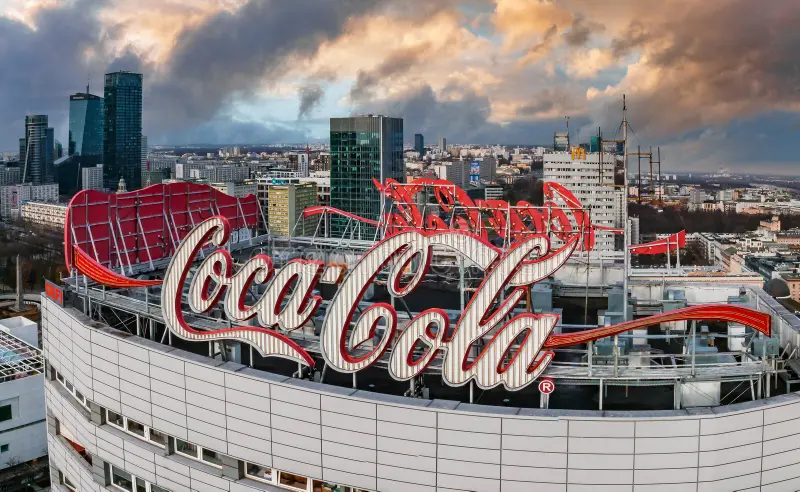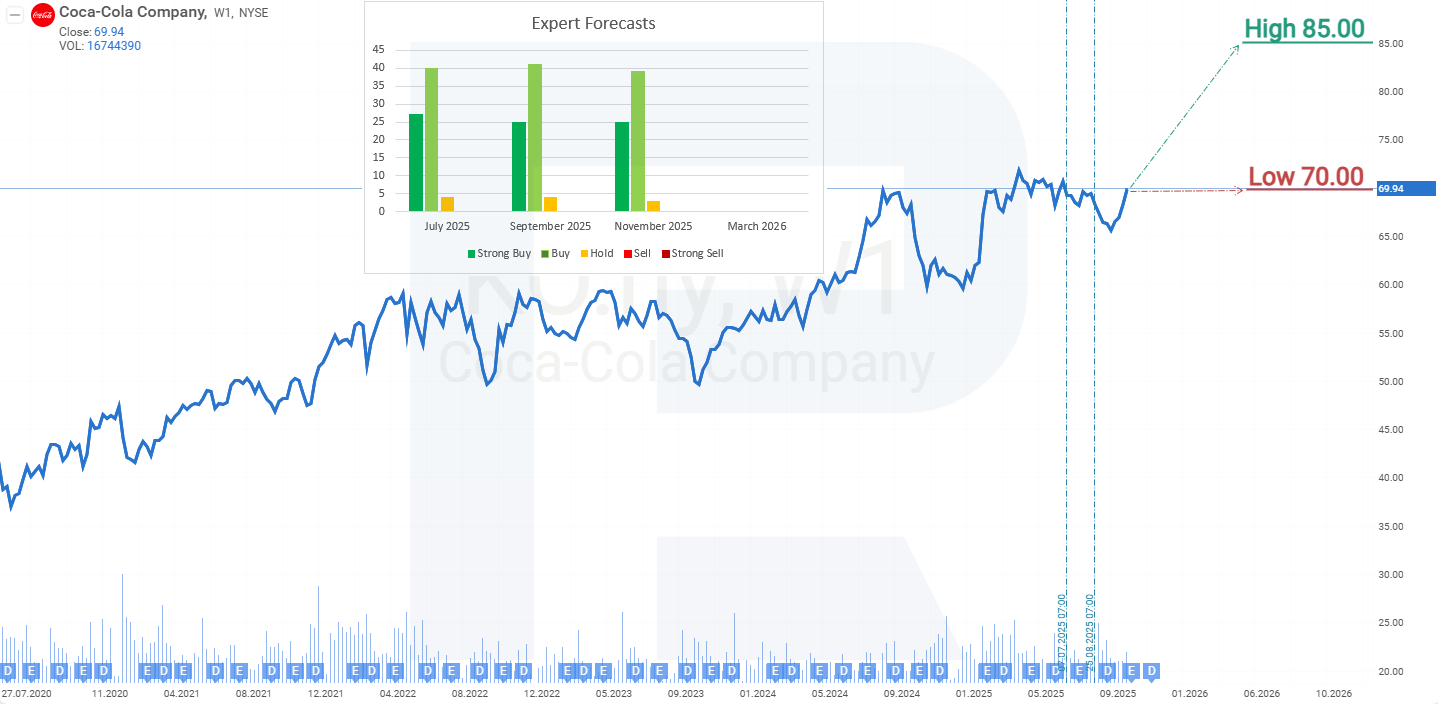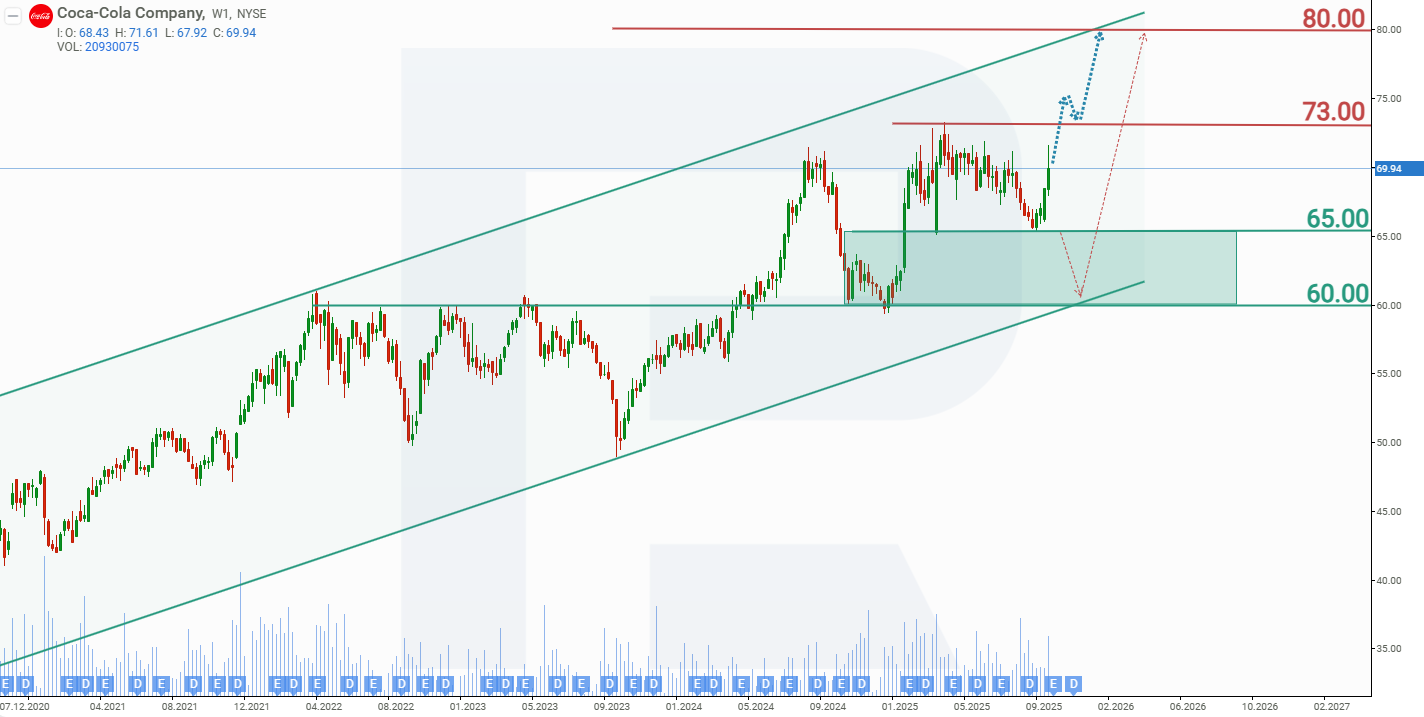The Coca-Cola Company shows steady growth and strengthens focus on its core business
The Coca-Cola Company’s Q3 2025 results came in slightly ahead of market expectations, confirming the business’s ongoing resilience. The company maintained its full-year outlook and announced the sale of a 75% stake in Coca-Cola Beverages Africa to focus on its core brands and production of beverage concentrates. As a result, the company’s shares rose by 4%, approaching an all-time high.
The Coca-Cola Company’s (NYSE: KO) Q3 2025 report came in slightly ahead of forecasts. Revenue totalled 12.5 billion USD (+5% y/y), marginally above market expectations of around 12.41 billion USD. Earnings per share were 0.86 USD (+6% y/y), also exceeding analyst estimates of roughly 0.78 USD. Organic growth reached 6%, driven mainly by higher prices and an improved product mix, while sales volumes increased by 1%.
Stronger growth was recorded in international markets, while demand in the US remained stable. The company offset this through pricing initiatives and packaging optimisation. In addition, Coca-Cola announced the sale of a 75% stake in its African subsidiary, Coca-Cola Beverages Africa, to its partner Coca-Cola HBC for about 2.6 billion USD – a move aimed at reducing capital intensity and focusing on its core brands and the production of beverage concentrates.
The company reaffirmed its 2025 guidance, expecting organic revenue growth of 5–6% and a 3% increase in adjusted EPS compared with 2024. Profit will remain under pressure from the stronger US dollar, which is expected to reduce full-year results by around 5 percentage points and Q4 by about –5%, although a modest positive currency effect on revenue is anticipated in the final quarter. More detailed guidance for 2026 will be provided in the next report.
Investors reacted positively to Coca-Cola’s Q3 2025 results. Following publication, the company’s shares rose by around 4%, as the report exceeded market expectations. Investors welcomed the fact that, even with modest sales volume growth of 1%, the company was able to increase revenue through a stronger price mix and an improved product portfolio. The market viewed Coca-Cola’s steady 2025 guidance and EPS growth as evidence of management’s confidence in the resilience of the business, despite moderate overall growth rates.
Analyst and investor commentary remained moderately positive. They pointed to solid organic growth and effective margin management but also noted that currency headwinds could weigh on profits. The sale of 75% of Coca-Cola Beverages Africa may create a short-term drag, potentially slowing growth slightly over the next few quarters.
This article reviews The Coca-Cola Company, outlines its revenue sources, summarises its Q1, Q2 and Q3 2025 financial results, and presents expectations for 2025. It also includes a technical analysis of KO shares, forming the basis for the 2025 stock forecast for The Coca-Cola Company.
About The Coca-Cola Company
The Coca-Cola Company is one of the world’s largest producers of non-alcoholic beverages. It was founded in 1886 by pharmacist John Stith Pemberton in Atlanta, Georgia. The company went public in 1919, listing on the New York Stock Exchange under the ticker KO.
Coca-Cola manufactures, markets, and sells carbonated soft drinks, juices, water, energy drinks, sports drinks, and tea-based beverages. It owns a portfolio of more than 200 brands, including Coca-Cola, Fanta, Sprite, Minute Maid, and Powerade.
Key competitors include PepsiCo, Nestlé, Keurig Dr Pepper and, in certain categories, local beverage producers.
Image of The Coca-Cola Company nameThe Coca-Cola Company’s main financial streams
The Coca-Cola Company’s business model is based on a global franchising and beverage distribution system, with revenue generated from several key sources:
- Sales of concentrates and syrups : this is the company’s primary revenue source, encompassing the sale of concentrates, syrups, and base ingredients to independent bottling partners. These partners produce, bottle, package, and distribute beverages under the Coca-Cola brand. The company earns stable income from the high-margin nature of this segment.
- Sales of finished beverages : Coca-Cola holds stakes in several bottling companies (such as Coca-Cola FEMSA and Coca-Cola HBC) and, in some regions, manages production and distribution independently. Revenue is generated across the entire value chain – from manufacturing through to the sale of finished products.
- Licensing fees and royalties : the company receives income from licences and brand usage. Bottlers pay royalties for the right to sell products under brands such as Coca-Cola, Fanta, Sprite, and others.
- Sales of other non-alcoholic beverages : beyond carbonated drinks, Coca-Cola generates revenue from juices (Minute Maid), water (Dasani, Smartwater), tea and coffee (Gold Peak, Georgia Coffee), energy drinks (Monster, BodyArmor), and sports drinks (Powerade). These brands contribute income through both concentrates and the sale of finished products.
- Advertising and marketing partnerships : indirect revenue streams include participation in joint advertising campaigns with retailers and major distributors, which help to increase sales volumes.
Thus, Coca-Cola’s business model relies on scalability, strong brands, franchising, and a broad product portfolio, enabling revenue generation from both raw materials and finished goods.
The Coca-Cola Company Q1 FY2025 report
On 29 April, The Coca-Cola Company published its Q1 FY2025 report for the period ending 28 March. Below are the key financial figures compared with the same period last year:
- Revenue : 11.13 billion USD (–2%)
- Net profit (GAAP) : 3.33 billion USD (+5%)
- Earnings per share : 0.73 USD (+1%)
- Operating margin : 33.8% (+120 basis points)
Revenue by country:
- Europe, Middle East & Africa : 2.66 billion USD (+1%)
- Latin America : 1.48 billion USD (–3%)
- North America : 4.36 billion USD (+3%)
- Asia Pacific : 1.42 billion USD (–4%)
Coca-Cola’s Q1 2025 financial report showed resilient operating results despite revenue pressure, with total revenue down 2% to 11.13 billion USD. The decline was primarily due to adverse currency effects and the refranchising of bottling operations to partners. Operating profit increased by 10%, with operating margin rising to 33.8% from 31.8% a year earlier, reflecting effective cost management, pricing strategy and benefits from refranchising.
Earnings per share rose by 1% to 0.73 USD, despite a significant negative currency impact of 5 percentage points. Global unit case volume grew by 2%, with robust growth recorded in India, China, and Brazil. Sales of Coca-Cola Zero Sugar increased by 14% across all regions.
Free cash flow was negative at –5.51 billion USD, primarily due to a one-off payment of 6.10 billion USD related to the Fairlife transaction. Excluding this item, free cash flow was 558 million USD.
Management reaffirmed its full-year 2025 guidance, forecasting organic revenue growth of 5-6% and non-GAAP EPS growth of 2–3%. Free cash flow was projected at around 9.50 billion USD. For Q2, the company indicated expected currency headwinds of about 3% on revenue and 5–6% on earnings per share.
The Coca-Cola Company Q2 2025 financial report
On 22 July, The Coca-Cola Company released its Q2 2025 financial report for the period ended 27 June. Below are the key financial results compared with the same period last year:
- Revenue : 12.53 billion USD (+5%)
- Net profit (GAAP) : 3.81 billion USD (+58%)
- Earnings per share : 0.87 USD (+4%)
- Operating margin : 34.7% (+190 basis points)
Revenue by region:
- Europe, Middle East & Africa : 3.21 billion USD (+6%)
- Latin America : 1.61 billion USD (–1%)
- North America : 5.04 billion USD (+3%)
- Asia Pacific : 1.59 billion USD (+5%)
In Q2 2025, Coca-Cola outperformed expectations across key metrics. Revenue grew by 5%, driven by a 6% contribution from pricing and product mix, offset by a 1% decline in volumes. Adjusted operating margin reached 34.7%, while earnings per share rose 4% to 0.87 USD, despite a 5% negative currency impact. Performance was particularly strong across international markets.
Free cash flow for the first half of the year was negative at 1.4 billion USD, reflecting a one-off payment of 6.1 billion USD related to the Fairlife transaction. Excluding this one-off payment, adjusted free cash flow was positive at 3.9 billion USD.
Coca-Cola updated its Q3 and H2 2025 outlook. The company reaffirmed its full-year guidance for organic revenue growth of 5–6% and raised its forecast for adjusted EPS growth to about 3%, towards the upper end of the previous 2–3% range. For Q3 2025, Coca-Cola expects currency headwinds of around 5–6 percentage points on adjusted EPS and about 1 percentage point on revenue.
The Coca-Cola Company Q3 2025 earnings results
On 21 October, The Coca-Cola Company (NYSE: KO) released its financial report for Q3 2025, which ended on 26 September. The key figures compared with those for the same period last year are as follows:
- Revenue : 12.45 billion USD (+5%)
- Net profit (GAAP) : 3.68 billion USD (+29%)
- Earnings per share : 0.86 USD (+30%)
- Operating margin : 32.0% (+1080 basis points)
Revenue by region:
- Europe, Middle East & Africa : 2.98 billion USD (+9%)
- Latin America : 1.56 billion USD (–6%)
- North America : 5.25 billion USD (+4%)
- Asia Pacific : 1.49 billion USD (+5%)
Coca-Cola’s Q3 2025 results came in slightly ahead of analyst expectations. Revenue totalled 12.5 billion USD, up 5% year-on-year and marginally above the market forecast of 12.41 billion USD. Adjusted earnings per share rose by 6% to 0.82 USD, also exceeding expectations of around 0.78 USD. Sales growth was driven mainly by higher prices and an improved product mix, while beverage volumes increased by 1%.
By region, the picture remained broadly consistent with Q2 2025: international markets showed stronger growth, while demand in the US remained stable. The company offset this through effective pricing strategies and packaging optimisation. Coca-Cola also announced the sale of a 75% stake in its African subsidiary, Coca-Cola Beverages Africa, to its partner Coca-Cola HBC for 2.6 billion USD. The transaction forms part of the company’s long-term strategy to transfer bottling operations to partners, reduce capital intensity, and focus on brand management and the production of beverage concentrates. Although the deal will slightly reduce revenue in 2025, it should simplify operations and improve overall profitability.
Management reaffirmed its 2025 guidance, expecting revenue growth of 5–6% and a 3% increase in adjusted EPS compared with 2024. Profitability continues to face pressure from the strengthening US dollar (around –5 percentage points) and structural changes. In Q4 2025, the company expects a modest positive currency effect on revenue, though the impact on profit will remain negative. Coca-Cola has not yet disclosed its forecast for 2026, noting only that the currency environment may improve slightly.
Fundamental analysis of The Coca-Cola Company
Below is the fundamental analysis of The Coca-Cola Company (NYSE: KO) based on the results for Q2 2025:
- Liquidity and access to financing : as of 26 September 2025, Coca-Cola held approximately 15.8 billion USD in liquid assets: 12.7 billion USD in cash, 1.1 billion USD in short-term investments, and 1.9 billion USD in marketable securities. Current assets totalled 27.2 billion USD, while current liabilities amounted to 22.5 billion USD, giving a current ratio of about 1.21 – a sound level for the consumer goods sector.
The company remains active in managing its debt instruments and commercial paper: during the first nine months of 2025, it raised 4.85 billion USD and repaid 4.17 billion USD. Its investment-grade credit ratings (A+/A1) ensure reliable access to funding at favourable rates.
- Debt and leverage : as of 26 September 2025, Coca-Cola’s total debt stood at around 47.4 billion USD, comprising 43.2 billion USD in long-term obligations, 1.9 billion USD in current maturities, and 2.3 billion USD in short-term borrowings. After deducting liquid assets, net debt is estimated at roughly 31.6 billion USD.
The interest burden remains low. In Q3, operating profit was 4.0 billion USD against interest expenses of 390 million USD – a coverage ratio of about 10×. Over the first nine months, operating profit reached 11.9 billion USD, while interest expenses totalled 1.22 billion USD – around 9.7× coverage, demonstrating the company’s strong ability to service its debt.
- Cash flow and dividend coverage : free cash flow for the first nine months of 2025 was 2.4 billion USD; excluding a one-off payment related to the fairlife LLC transaction, it was approximately 8.5 billion USD. Management forecasts full-year 2025 FCF of at least 9.8 billion USD, excluding this one-time expense.
During the same period, Coca-Cola paid 4.39 billion USD in dividends to shareholders (two payments of 0.51 USD per share). The current quarterly dividend stands at 0.51 USD, implying an annual rate of 2.04 USD. Based on projected FCF excluding fairlife, dividends are covered by around 1.1× – a stable, though modest, margin of safety.
Conclusion – fundamental view on The Coca-Cola Company
The company’s balance sheet remains robust: the current ratio stands at about 1.21, net debt is roughly 31.6 billion USD, and interest coverage is close to 10×. Free cash flow comfortably covers dividend payments.
Among strategic initiatives, the sale of a 75% stake in Coca-Cola Beverages Africa to its partner, Coca-Cola HBC, reduces the business’s capital intensity and makes the company’s model more efficient. In the short term, this may slightly reduce revenue, but in the long term, it should improve return on capital and enhance overall business quality.
Expert forecasts for The Coca-Cola Company stock
- Barchart : 21 out of 25 analysts rated Coca-Cola shares as Strong Buy, 2 as Moderate Buy, and 2 as Hold. The upper forecast limit is 85 USD, while the lower stands at 70 USD.
- MarketBeat : all 16 analysts rated the stock as Buy. The highest forecast is 83 USD, and the lowest is 70 USD.
- TipRanks : 13 out of 14 analysts issued a Buy rating, and 1 recommended Hold. The top forecast level is 85 USD, with the bottom at 70 USD.
- Stock Analysis : 4 out of 12 experts rated the shares as Strong Buy, and 8 as Buy. The upper forecast limit is 83 USD, and the lower is 70 USD.
The Coca-Cola Company stock price forecast for 2025
On the weekly timeframe, The Coca-Cola Company’s shares continue to trade within an upward channel. The publication of the Q3 2025 report revived investor demand for the stock – growth of this scale had not been seen over the previous two quarters. Following the report’s release, the share price rose by about 4%. Against this backdrop, the likelihood of a breakout above the all-time high at 73 USD has increased. Based on the current price dynamics, the possible scenarios for The Coca-Cola Company’s share performance in 2025 are as follows:
The base-case forecast for The Coca-Cola Company shares suggests a breakout above resistance at 73 USD, followed by a rise towards the upper boundary of the channel near 80 USD.
The alternative forecast for The Coca-Cola Company stock assumes a break below support at 65 USD. In this scenario, KO could decline towards the trendline around 60 USD, which serves as a key support level. Given the company’s financial strength, regular dividend payments, and ongoing share buyback program, demand for KO shares is likely to increase around the 60 USD level.
The Coca-Cola Company stock analysis and forecast for 2025Risks of investing in The Coca-Cola Company stock
Investing in Coca-Cola stock involves macroeconomic, industry-specific, and company-level risks that may negatively impact its revenue. The key risks include:
- Shifts in consumer preferences : the growing focus on healthy lifestyles and declining consumption of sugary drinks could negatively affect sales of Coca-Cola’s traditional products, including Coca-Cola and Fanta.
- Regulatory restrictions and taxation : many countries are introducing or considering regulations on advertising and labelling of high-sugar products. These measures may dampen demand and increase operational costs.
- Currency fluctuations : with over half of Coca-Cola’s revenue generated internationally, exchange rate movements – particularly a stronger US dollar– can reduce reported revenue and profit in dollar terms.
- Geopolitical and economic risks in international markets : instability in emerging economies, inflation, trade restrictions, sanctions, or local crises can lead to demand disruptions, supply chain issues, and losses in overseas markets.
- Reliance on franchised bottlers : although Coca-Cola sells concentrates, brand success heavily depends on the performance of bottling partners. Challenges related to logistics, product quality, or operational stability among these partners can negatively impact sales.
- Competition within the beverage industry : Coca-Cola faces strong competition from PepsiCo, Nestlé, Keurig Dr Pepper, and numerous local brands. Increasing competition may result in price pressure, market share losses, or the need for higher marketing expenditure.
- Legal and reputational risks : scandals involving product quality, labour conditions, or partner conduct can damage brand image and result in short-term sales declines.
These risks highlight Coca-Cola’s sensitivity to changes in global consumer trends, regulation, and its operational network, and should be considered by investors when evaluating the company’s outlook.
Forecasts presented in this section only reflect the author’s private opinion and should not be considered as guidance for trading. RoboForex bears no responsibility for trading results based on trading recommendations described in these analytical reviews.




